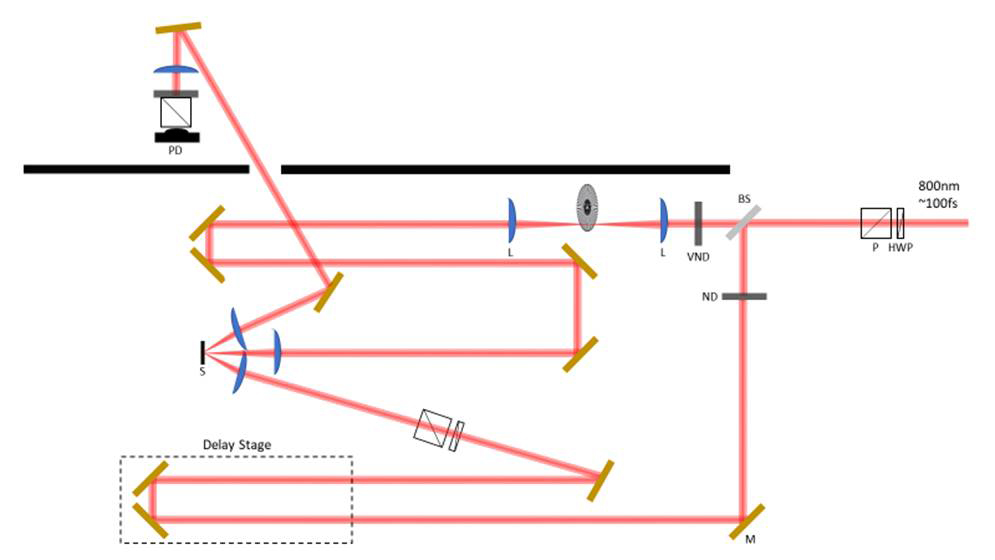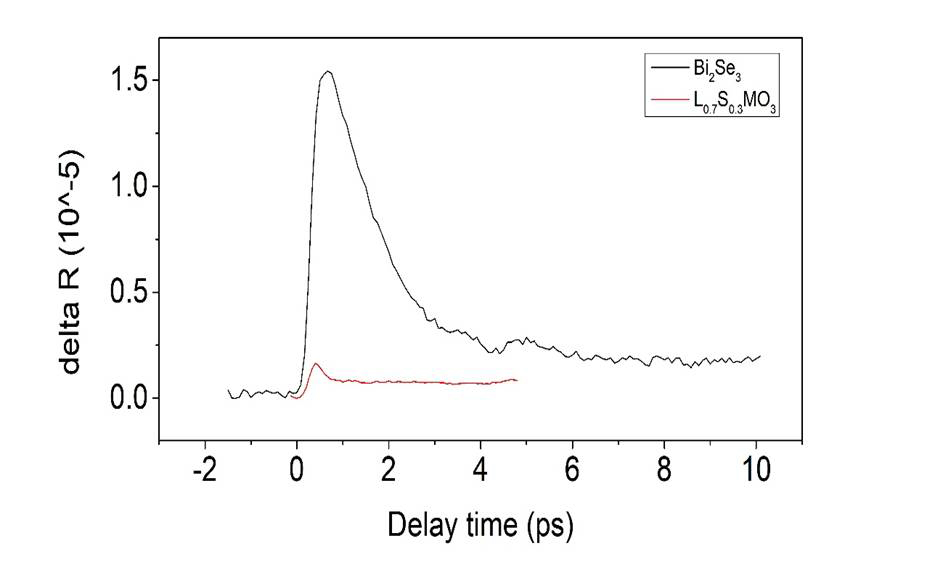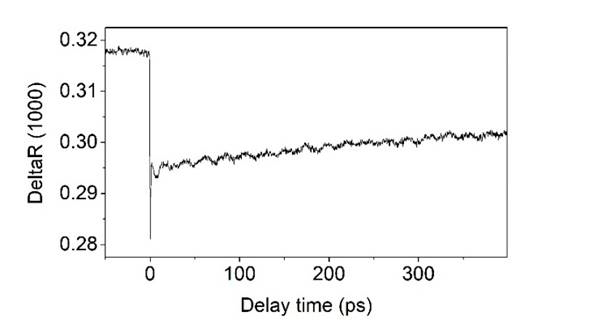Reports: ND1056642-ND10: A New Ability to Study Ultrafast Spectroscopy in Natural Oxides
Mikel Holcomb, PhD, West Virginia University
The primary objective of this research is to understand the linear and nonlinear optical properties of La0.7Sr0.3MnO3 (LSMO) films and relate these findings to natural oxide systems. Two optical setups—one for second harmonic generation (SHG) and another for reflectivity—have been designed and optimized for the study of ultrafast spectroscopy in oxides. There is little published work on SHG from LSMO. This is not surprising, since bulk LSMO has an R-3c space group which is centrosymmetric and therefore SHG is forbidden in the electric dipole approximation. Although SHG is forbidden in bulk LSMO, there is a break in symmetry at the surface and the interface with substrates (here: SrTiO3).
Figure 1: SHG polar plots of SH response with sample rotation. Reference GaAs (right) demonstrates excellent optics alignment with expected 4-fold rotation symmetry and consistent intensities.
Our SHG setup consists of a Ti:Sapphire laser at 800nm, 150fs pulses at 80MHz repetition rate, various optics, a rotating sample holder on an X-Y stage, a photo-multiplier tube for detection, and a lock-in amplifier. Several of our LSMO samples exhibit rotational anisotropy of the second harmonic intensity (RA-SHG). The symmetry of this data reveals the underlying symmetry of the surface/interface. We see 3-fold and 4-fold symmetry from different spots on samples, indicating that the surface/interface may be structurally or electronically different on a microscopic scale, which has recently been observed in other smooth single crystalline systems. The laser beam is focused to a spot approximately 100 µm in diameter, so any SHG signal should come from this small area. RA-SHG data usually has some degree of symmetry to it, nevertheless it has been shown that this can be asymmetric due to vicinal surfaces or different surface reconstructions. We are submitting a proposal to work with Oak Ridge to do in-situ scanning probe microscopy to explore these possibilities. Preliminary results in Figure 1 show RA-SHG from LSMO films and reference GaAs under similar conditions. We are in the process of attempting to correlate RA-SHG asymmetry with surface/interface properties such as roughness, surface reconstruction, miscut angle, oxygen vacancy density and space charge from polar interfaces.
Figure 2: Ultrafast pump-probe setup in reflectivity mode allows the study of ultrafast dynamics.
Figure 2 illustrates the primary optics in our pump-probe setup. A pump beam excites the material system and the probe beam measures the effect of this excitation on the sample. By measuring the change in the rise and decay constants with power and sample thickness, one can learn a great deal about carrier dynamics, which is important for applications.
Figure 3: Ultrafast carrier dynamics of topological insulator Bi2Se3 versus La0.7Sr0.3MnO3 illustrating differences in pump-probe reflectivity.
As these types of setups can be quite sensitive, we have had to optimize various parts of the setup which slowed our progress. However, our setup is now very sensitive to small signals. To demonstrate this sensitivity, consider the two pump-probe signals shown in Figure 3. The y-axis is the change in the reflectivity and the x-axis is the time delay in picoseconds between the pump and probe. The larger pump-probe response in Figure 3 originates from topological insulator Bi2Se3. Topological insulators have received a great deal of attention recently due to the interesting difference between surface and bulk properties and potential applications. The small response originates from our LSMO thin film under similar measurement conditions. The LSMO signal is much smaller, which is why the optimization of our setup is particularly critical for materials like this.
Despite the small signals, we have been able to get interesting results. Figure 4 shows the ultrafast free carrier dynamics of a 43 nm LSMO thin film for different excitation powers. The main figure and inset curves show two different time ranges to illustrate both short and long time dynamics. The dynamics mainly consist of an ultrafast decay (<1ps), followed by two or three longer (~100ps, ~1ns) decays. Each of these decays are related to different recombination phenomena. For example, the ultrafast decay originates from the Auger recombination which is due to third party free carrier transition. Longer recombination can be due to Shockley-Read-Hall recombination or inter-band free carrier transition (radiative recombination).
Figure 4: Power dependence for a 43 nm thick LaSrMnO3 film. Inset shows short time scales.
While our main goal was to study the ultrafast free carrier dynamics, by taking smaller time steps, we noticed oscillations shown in Figure 5. The Fourier transform of these oscillations (right) yielded frequency determination of the oscillations. Since the primary frequency of oscillation is about 43 GHz, the oscillations likely correspond to acoustic phonons. We plan to study the change in these time scales and oscillations with thickness to learn more about the boundary properties of LSMO thin films.
Figure 5: Oscillations in time dependence and Fourier transform.
We have also begun working on other efforts for this project. As proposed, we are also optimizing and exploring other material systems. With our collaborators, a paper has been submitted to Topics in Catalysis on films of CuFeO2 and CuFe0.75Ga0.25O2. Samples were characterized by X-ray diffraction, Raman spectroscopy, atomic force microscopy, and X-ray and UV photoelectron spectroscopy. In both systems Cu and Fe are exposed at the surface-gas interface. Data indicated that CO2 adsorb preferentially at Cu sites forming similar coordination to CuCO3. The energy for desorption of CO2 and H2O was estimated to be 1.3 eV/atom for CuFeO2 and 1.6 eV/mol for CuFe0.75Ga0.25O2. UV photoelectron spectroscopy showed that the valence band of the CuFeO2 delafossite oxides is modified with the substitution of Fe by Ga in the crystal lattice. The semiconductor band gap of CuFeO2 delafossite oxides also increased from 1.2 eV to 1.5 eV due to the substitution of Fe by Ga in the crystal lattice. We plan to do pump-probe dynamics with these and/or other systems after we are finished with the thickness and power dependence in LaSrMnO3. Not all materials show a strong pump-probe signal, so we will adjust as necessary.

















